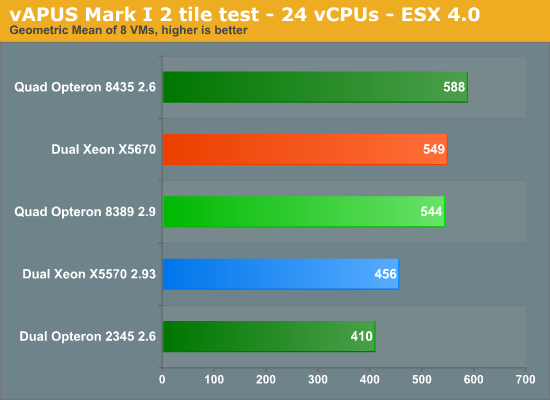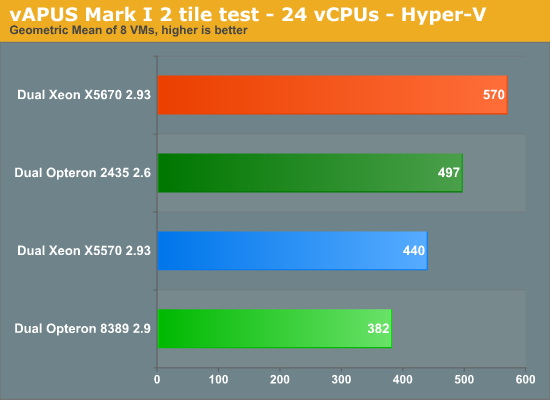The Intel Xeon 5670: Six Improved Cores
by Johan De Gelas on March 16, 2010 3:39 PM EST- Posted in
- IT Computing
vApus Mark I: Performance-Critical applications virtualized
Our vApus Mark I benchmark is not a VMmark replacement. It is meant to be complimentary: while VMmark uses runs 60 to 120 light loads, vApus Mark I runs 8 heavy VMs on 24 virtual CPUs (vCPUs). Our current vApus Stressclient is being improved to scale to much higher amount of vCPUs, but currently we limit the benchmark to 24 virtual CPUs.
A vApus Mark I tile consists of one OLTP, one OLAP and two heavy websites are combined in one tile. These are the kind of demanding applications that still got their own dedicated and natively running machine a year ago. vApus Mark I shows what will happen if you virtualize them. If you want to fully understand our benchmark methodology: vApus Mark I has been described in great detail here. We have changed only one thing compared to our original benchmarking: we used large pages as it is generally considered as a best practice (with RVI, EPT).
The current vApus Mark I uses two tiles. Per tile we have thus 4 VMs with 4 server applications:
- A SQL Server 2008 x64 database running on Windows 2008 64-bit, stress tested by our in-house developed vApus test (4 vCPUs).
- Two heavy duty MCS eFMS portals running PHP, IIS on Windows 2003 R2, stress tested by our in house developed vApus test (each 2 vCPUs).
- One OLTP database, based on Oracle 10G Calling Circle benchmark of Dominic Giles (4 vCPUs).
The beauty is that vApus (stress testing software developed by the Sizing Servers Lab) uses actions made by real people (as can be seen in logs) to stress test the VMs, not some benchmarking algorithm.

As always, vApus Mark paints a totally different picture than VMmark. In this case, “only” 8 Opteron cores are needed to keep up with the six Xeons. While right now the Xeon X5670 is ahead with a significant margin (34%) on the current six-core Opteron, an octal-core Opteron might be competitive, on the condition that AMD prices it right.
We are proud to present you our first vApus Mark I on Hyper-V. One of the great advantages of our virtualization benchmark is that it runs on all popular hypervisors. Below we tested with Hyper-V R2 6.1.7600.16385 (21st of July 2009).

Hyper-V R2 performs well, very well. The scheduler prefers to work with a number of physical CPUs that can be easily divided among the virtual CPUs. Contrary to ESX, where the 16 logical cores of the Xeon X5570 prevail, Hyper-V prefers the twelve cores of the Opteron 2435, much to our surprise. It interesting to see that ESX seems to prefer the Nehalem based architectures much more than Hyper-V. With ESX the gap between the six-core Opteron and six-core Xeon is 34%. With Hyper-V, this shrinks to 15%.
Take our results with a grain of salt though, as this is the very first time we have run vApus Mark I on Hyper-V on different architectures. We need more analyzing time to understand what is going on. My first bet is that ESX is very well optimized for the Nehalem architecture. This includes the excellent Hyper-threading optimizations and probably some optimizations to avoid one of the few Nehalem architecture limitations: the small “prefetch” (16 byte on Nehalem, 32 byte on Istanbul) and especially the relatively small TLB. That is pure speculation though, we will need more time to investigate this.










40 Comments
View All Comments
yinan - Tuesday, March 16, 2010 - link
Bah 6 cores. 8 sockets by 8 cores is where it is at :)landerf - Tuesday, March 16, 2010 - link
I always wish with these server/workstation part reviews that we could get a gaming page just for kicks. Specifically in this case I'm thinking of the upcoming dual socket EVGA board and if it will have any effect on games or if it will be only synthetics that show a benefit. I'd also like to see a modern workstation card vs it's mainstream counterpart to see if the gaming performance gap has gotten smaller or larger over the years. I think recently there's been a push to make workstation cards do better in 3d games so you can test your work on the same rig, cutting back on the number of systems.GeorgeH - Tuesday, March 16, 2010 - link
I'd also be curious to see the E5620 overclocked in a consumer board, as its ~$400 price fills the hole between the ~$300 i7-920/930 and the ~$600 i7-950 rather nicely.Intel's PR people would probably get pissed, but screw 'em.
jonup - Tuesday, March 16, 2010 - link
I was about to post the same. There is a lot of people using Xeons in X58 and P55 boards. Some prefer the lower power consumption others beleive the Xeons oc better. Please show us the money!DigitalFreak - Tuesday, March 16, 2010 - link
You do realize that the 55xx/56xx series Xeons only work in dual socket motherboards?!?GeorgeH - Tuesday, March 16, 2010 - link
I think you've got that backwards. A dual socket motherboard needs 5-series chips, but a 5-series should work in a single socket board just fine. In general it'd be silly to run only one (a 2.66GHz W3520 costs ~$300 while a 2.66GHz X5550 costs ~$1000) but if the cheapest 32nm LGA-1366 chip is a 5-series Xeon it might be worth it.jonup - Wednesday, March 17, 2010 - link
But you can get E5520 @2.26GHz for $390 and get a faster QPI.greylica - Tuesday, March 16, 2010 - link
Blender 3D 2.50 in his Alpha 2 Stage supports 64 simultaneous Threads, and it's not hard to make benchmarks, and I am missing Blender 3D benchmarks in every processor launch, what happened with ''Blender 3D Character benchamrks'' ?Blender can extract blood from those ''beasts''...
JohanAnandtech - Wednesday, March 17, 2010 - link
I have indeed heard more than once that Blender is getting really popular. "Alpha 2" does not sound like the software is very stable. Any suggestion to what kind of scene I should use? The scene choice is very important as the parallel rendering part must be long enough compared to some of serial parts in the process. You can mail me at johan@anandtech.com if you like. I am open to suggestions.MySchizoBuddy - Tuesday, March 16, 2010 - link
Also add HPC related benchmarks